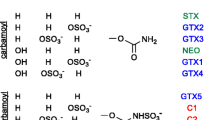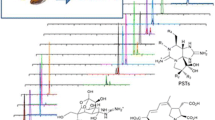Abstract
Marine biotoxins pose a significant food safety risk when bioaccumulated in shellfish, and adequate testing for biotoxins in shellfish is required to ensure public safety and long-term viability of commercial shellfish markets. This report describes the use of a benchtop Orbitrap system for liquid chromatography–mass spectrometry (LC-MS) screening of multiple classes of biotoxins commonly found in shellfish. Lipophilic toxins such as dinophysistoxins, pectenotoxins, and azaspiracids were separated by reversed phase LC in less than 7 min prior to MS data acquisition at 2 Hz with alternating positive and negative scans. This approach resulted in mass accuracy for analytes detected in positive mode (gymnodimine, 13-desmethyl spirolide C, pectenotoxin-2, and azaspiracid-1, -2, and -3) of less than 1 ppm, while those analytes detected in negative mode (yessotoxin, okadaic acid, and dinophysistoxin-1 and -2) exhibited mass errors between 2 and 4 ppm. Hydrophilic toxins such as domoic acid, saxitoxin, and gonyautoxins were separated by hydrophilic interaction LC (HILIC) in less than 4 min, and MS data was collected at 1 Hz in positive mode, yielding mass accuracy of less than 1 ppm error at a resolving power of 100,000 for the analytes studied (m/z 300–500). Data were processed by extracting 5 ppm mass windows centered around the calculated masses of the analytes. Limits of detection (LOD) for the lipophilic toxins ranged from 0.041 to 0.10 μg/L (parts per billion) for the positive ions, 1.6–5.1 μg/L for those detected in negative mode, while the domoic acid and paralytic shellfish toxins yielded LODs ranging from 3.4 to 14 μg/L. Toxins were detected in mussel tissue extracts free of interference in all cases.





Similar content being viewed by others
References
Moestrup Ø, Akselman R, Cronberg G, Elbraechter M, Fraga S, Halim Y, Hansen G, Hoppenrath M, Larsen J, Lundholm N, Nguyen LN, Zingone A (2009) IOC-UNESCO taxonomic reference list of harmful micro algae. Available online at http://www.marinespecies.org/HAB. Accessed on 25 Oct 2010
Commission Regulation (EC) No. 2074/2005 of 5 December 2005 laying down implementing measures for certain products under Regulation (EC) No. 853/2004 of the European Parliament and of the Council and for the organisation of official controls under Regulation (EC) No. 854/2004 of the European Parliament and of the Council and Regulation (EC) No. 882/2004 of the European Parliament and of the Council, derogating from Regulation (EC) No. 852/2004 of the European Parliament and of the Council and amending Regulations (EC) No. 853/2004 and (EC) No. 854/2004 (2005). Official Journal of the European Union L 338/48
(2009) Scientific Opinion of the Panel on Contaminants in the Food Chain on a request from the European Commission on Marine Biotoxins in Shellfish—summary on regulated marine biotoxins. The EFSA Journal 1306:1–23
Hess P (2010) Requirements for screening and confirmatory methods for the detection and quantification of marine biotoxins in end-product and official control. Anal Bioanal Chem 397:1683–1694
McNabb P, Selwood AI, Holland PT (2005) Multiresidue method for determination of algal toxins in shellfish: single-laboratory validation and interlaboratory study. J AOAC Int 88:761–772
Fux E, McMillan D, Bire R, Hess P (2007) Development of an ultra-performance liquid chromatography-mass spectrometry method for the detection of lipophilic marine toxins. J Chromatogr A 1157:273–280
Gerssen A, Mulder PPJ, McElhinney MA, de Boer J (2009) Liquid chromatography-tandem mass spectrometry method for the detection of marine lipophilic toxins under alkaline conditions. J Chromatogr A 1216:1421–1430
Gerssen A, Van Olst EHW, Mulder PPJ, De Boer J (2010) In-house validation of a liquid chromatography tandem mass spectrometry method for the analysis of lipophilic marine toxins in shellfish using matrix-matched calibration. Anal Bioanal Chem 397:3079–3088
Quilliam MA, Xie M, Hardstaff WR (1995) Rapid extraction and cleanup for liquid chromatographic determination of domoic acid in unsalted seafood. J AOAC Int 78:543–546
Mafra LL Jr, Leger C, Bates SS, Quilliam MA (2009) Analysis of trace levels of domoic acid in seawater and plankton by liquid chromatography without derivatization, using UV or mass spectrometry detection. J Chromatogr A 1216:6003–6011
Lawrence JF, Niedzwiadek B (2001) Quantitative determination of paralytic shellfish poisoning toxins in shellfish by using prechromatographic oxidation and liquid chromatography with fluorescence detection. J AOAC Int 84:1099–1108
Lawrence JF, Niedzwiadek B, Menard C (2005) Quantitative determination of paralytic shellfish poisoning toxins in shellfish using prechromatographic oxidation and liquid chromatography with fluorescence detection: collaborative study. J AOAC Int 88:1714–1732
Rourke WA, Murphy CJ, Pitcher G, Van De Riet JM, Burns BG, Thomas KM, Quilliam MA (2008) Rapid postcolumn methodology for determination of paralytic shellfish toxins in shellfish tissue. J AOAC Int 91:589–597
Van De Riet JM, Gibbs RS, Chou FW, Muggah PM, Rourke WA, Burns G, Thomas K, Quilliam MA (2009) Liquid chromatographic post-column oxidation method for analysis of paralytic shellfish toxins in mussels, clams, scallops, and oysters: single-laboratory validation. J AOAC Int 92:1690–1704
Dell'Aversano C, Hess P, Quilliam MA (2005) Hydrophilic interaction liquid chromatography-mass spectrometry for the analysis of paralytic shellfish poisoning (PSP) toxins. J Chromatogr A 1081:190–201
Turrell E, Stobo L, Lacaze JP, Piletsky S, Piletska E (2008) Optimization of hydrophilic interaction liquid chromatography/mass spectrometry and development of solid-phase extraction for the determination of paralytic shellfish poisoning toxins. J AOAC Int 91:1372–1386
Diener M, Erler K, Christian B, Luckas B (2007) Application of a new zwitterionic hydrophilic interaction chromatography column for determination of paralytic shellfish poisoning toxins. J Separation Sci 30:1821–1826
Schurmann A, Dvorak V, Cruzer C, Butcher P, Kaufmann A (2009) False-positive liquid chromatography/tandem mass spectrometric confirmation of sebuthylazine residues using the identification points system according to EU directive 2002/657/EC due to a biogenic insecticide in tarragon. Rapid Comm Mass Spectrom 23:1196–1200
Grimalt S, Sancho JV, Pozo OJ, Hernandez F (2010) Quantification, confirmation and screening capability of UHPLC coupled to triple quadrupole and hybrid quadrupole time-of-flight mass spectrometry in pesticide residue analysis. J Mass Spectrom 45:421–436
Kellmann M, Muenster H, Zomer P, Mol H (2009) Full scan MS in comprehensive qualitative and quantitative residue analysis in food and feed matrices: how much resolving power is required? J Am Soc Mass Spectrom 20:1464–1476
Zhang NR, Yu S, Tiller P, Yeh S, Mahan E, Emary WB (2009) Quantitation of small molecules using high-resolution accurate mass spectrometers—a different approach for analysis of biological samples. Rapid Commun Mass Spectrom 23:1085–1094
Bateman KP, Kellmann M, Muenster H, Papp R, Taylor L (2009) Quantitative-qualitative data acquisition using a Benchtop Orbitrap mass spectrometer. J Am Soc Mass Spectrom 20:1441–1450
Krauss M, Singer H, Hollender J (2010) LC–high resolution MS in environmental analysis: from target screening to the identification of unknowns. Anal Bioanal Chem 397:943–951
Perez RA, Rehmann N, Crain S, LeBlanc P, Craft C, MacKinnon S, Reeves K, Burton IW, Walter JA, Hess P, Quilliam MA, Melanson JE (2010) The preparation of certified calibration solutions for azaspiracid-1,-2, and-3, potent marine biotoxins found in shellfish. Anal Bioanal Chem 398:2243–2252
McCarron P, Emteborg H, Nulty C, Rundberget T, Loader JI, Miles CO, Emons H, Quilliam MA, Hess P (2011) A mussel tissue certified reference material for multiple toxins: part 1: design and preparation. Anal Bioanal Chem doi:10.1007/s00216-011-4786-9
Brenton AG, Godfrey AR (2010) Accurate mass measurement: terminology and treatment of data. J Am Soc Mass Spectrom 21:1821–1835
Acknowledgements
The authors wish to thank Dr. Pearse McCarron for reviewing this manuscript and for providing extracts of the reference material containing lipophilic toxins. Loan of the Exactive™ mass spectrometer from Thermo Fisher Scientific is also gratefully acknowledged. This is NRC publication number 51791.
Author information
Authors and Affiliations
Corresponding author
Electronic supplementary material
Below is the link to the electronic supplementary material.
ESM 1
(PDF 320 kb)
Rights and permissions
About this article
Cite this article
Blay, P., Hui, J.P.M., Chang, J. et al. Screening for multiple classes of marine biotoxins by liquid chromatography–high-resolution mass spectrometry. Anal Bioanal Chem 400, 577–585 (2011). https://doi.org/10.1007/s00216-011-4772-2
Received:
Revised:
Accepted:
Published:
Issue Date:
DOI: https://doi.org/10.1007/s00216-011-4772-2




